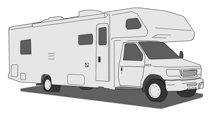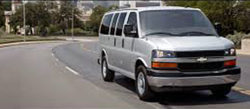CPSTs should be prepared for a potential rise in RV interest among families. In a study published earlier this year, researchers compared the cost of visiting nine popular U.S. tourist destinations over three vacation durations. For every scenario, the researchers concluded that traveling by RV was significantly less expensive than trips involving other modes of transportation (planes, cars) or lodging (hotels, rental properties).
Read More from “Editorial: RV Travel Savings Unlikely to Pencil Out When Safety Is Added to the Equation”Topic: Traveling with Children
Traveling with children in motorcoaches, RVs, taxis, aircraft, and ride share vehicles.
“Help! Riding Rear Facing Makes My Child Sick!”
CPSTs are occasionally approached by caregivers whose children struggle with car sickness, and those with younger children sometimes wonder if riding rear facing is the crux of this problem. In Washington state (where the law requires children to ride rear facing until age 2), state CPS coordinator Cesi Velez was asked a question on this theme. The caregiver of a 19-month-old wanted to know if a doctor could issue her a letter of exemption from the state’s child occupant protection (COP) law. Her child had been vomiting in her car seat, and the parent felt that having the child face forward would solve the problem.
Read More from ““Help! Riding Rear Facing Makes My Child Sick!””Reporter Confronts Common Myths About Full-Size Vans and CRs
Personal experience led Washington Post reporter and parent Lauren Gravitz to write the recent article “Risky transport: Camps, churches and other programs are trading car-seat safety for convenience.” Read More from “Reporter Confronts Common Myths About Full-Size Vans and CRs”
CRs May Help Prevent In-Flight Injuries
CPSTs know that children on aircraft are better protected from injury when riding in an approved CR due to the potential of turbulence or crashes. Recently, a new study identified an additional reason: in-flight medical emergencies. In particular, the researchers (three doctors from U.S. universities and hospitals) looked at the in-flight injuries (IFIs, typically trauma or burns) that children sustained. They found such incidents to be infrequent relative to the number of such events to all passengers, but not negligible. Their takeaway: The protection CRs can provide with respect to potential IFIs can expand their in-flight benefits beyond during takeoff, landing, and turbulence.
Motorcoach Safety: Agency Provides Guidance For Booking a Safer Trip
A motorcoach is a large, non-school bus that does not serve fixed routes (like city transit), but instead travels longer distances, usually on highways. While motorcoaches have a relatively good safety record compared to most other vehicle types, they do not have many of the safety features required of school buses. Nonetheless, groups of children frequently use these types of buses for field trips and sports outings, especially when the trip covers long distances.
Read More from “Motorcoach Safety: Agency Provides Guidance For Booking a Safer Trip”
Children in Aircraft
“We are flying to my mother’s, and I see that I can carry my 1-year-old on my lap, which will save us a lot of money . . .”
The temptation to save money by having a child under age 2 ride on a parent’s lap presents a common dilemma for families. Adding to the confusion is the fact that airlines and the FAA seem to condone the unsafe behavior and that most people figure a plane crash cannot be survived, with or without a CR.
The truth is that all passengers, including young children, are safer when buckled up on an airplane. Although the FAA concluded in August 2005 that it would not require families to purchase a seat for children under age 2, the rationale was data (since convincingly refuted) showing that families would prefer to drive (generally more risky) if they otherwise would have to purchase a plane ticket for the child.
Children in RVs
“We are planning a big cross-country tour this summer and figure it would make sense to rent an RV for this adventure . . .”
Often, even parents who normally are careful to use a CR for their children for every ride imagine that the interior of a recreational vehicle (RV, or motor home) is somehow a magical zone where the laws of physics do not apply. Caregivers need to know that an RV may not be safe for children.
Children still need to be buckled up appropriately any time they are riding in a vehicle, and this can be a real challenge in an RV. RVs come in a range of style classes (A, B, C, C+, etc.) and, although these do vary in appropriateness for families, none is ideal.
Children in Taxis
“We are visiting a large city, so we will be using taxis rather than a rental car . . .”
A 2006 study using 2004 data found that, in New York City alone, there were 25 taxi/livery crashes every day that caused injury. That study also found that when taxis were involved in a crash, the taxi passengers were nearly 2.5 times more likely to be seriously injured or killed than the passengers in the other vehicle in the crash.
So, best practice in taxis (and, in some states, the law) is to use a CR. Dr. Alisa Baer, pediatrician and cofounder of The Car Seat Lady, posts excellent advice on this subject at www.thecarseatlady.com.
UberFamily Adds CR Option
Visiting NYC? Check out this safety option for kids
In May, options for traveling safely with kids in New York City improved dramatically. Uber, a tech company that creates mobile apps to connect passengers with drivers of for-hire vehicles, added a new option, uberFAMILY. For an upcharge of $10 per ride, customers selecting uberFAMILY from the Uber app will be sent a car that has a forward-facing CR with a five-point harness preinstalled by a trained driver. The service is offered for children over age 1 (and at least 22 pounds/31 inches) and up to 48 pounds or 52 inches. (Children smaller and larger than that are urged to use the appropriate RF-only CR or booster, respectively.)





